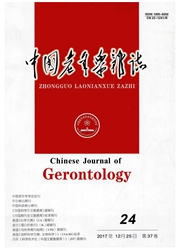

 中文摘要:
中文摘要:
目的探讨帕瑞昔布钠对老年膝关节置换术患者术后早期认知功能的影响。方法 42例择期行膝关节置换术的老年患者,采用随机数字表法,分为帕瑞昔布钠组(P组,n=20)和对照组(C组,n=22)。麻醉诱导前15 min及术后12 h,P组静脉注射帕瑞昔布钠40 mg,C组给予等容量生理盐水。分别于麻醉诱导前(T1)、术后4 h(T2)、24 h(T3)、48 h(T4)抽取外周静脉血,采用ELISA法检测血清中白介素(IL)-6、肿瘤坏死因子(TNF)-α浓度。并于术前1 d及术后7 d,采用简易智能状态量表(MMSE)进行认知功能评估。结果与T1比较,P组和C组T2、T3、T4时血清IL-6、TNF-α浓度明显增加(P〈0.05)。P组T2、T3、T4时血清IL-6浓度低于C组(P〈0.05),TNF-α浓度两组间无显著差异(P〉0.05);术后认知功能障碍(POCD)发生率P组低于C组,但差异无统计学意义(P〉0.05)。结论帕瑞昔布钠能够降低老年膝关节置换术患者术后早期IL-6、TNF-α表达水平,但并未降低老年膝关节置换术患者早期POCD的发生率。
 英文摘要:
英文摘要:
Objective To investigate the effect of parecoxib sodium on postoperative cognitive dysfunction(POCD) in elderly under- going total knee replacement. Methods 42 elderly patients undergoing elective operation on total knee replacement were randomly divided into parecoxib (group P, n = 20) and control groups (group C, n : 22). The patients in group P were given intravenous parecoxib 40 mg 15 min before induction of anesthesia and 12 h after the surgery. Ones in group C equal volume normal saline were given instead of parecoxib. Venous blood samples were collected immediately before induction of anesthesia( T1 ) ,4 h after operation( T2 ), 24 h postoperatively(T3 )and 24 h postoperatively( T4 ). The plasma levels of IL-6 and TNF-α were measured. Neuropsychological testing was performed with mini-mental state examination(MMSE) on the preoperative day and 7th postoperative day. Results The serum levels of IL-6 and TNF-α in both groups were significantly higher at T2, T3 and T4 than those at T1. At T2, T3 and T4 , postoperative serum levels, of IL-6 was lower in group P than that of group C(P 〈0. 05), but serum level of TNF-α had no statistically significant difference between group P and group C at T2, T2 and T4. The incidence of POCD in the group P was lower than that of group C, but had no statistically significant difference(P 〉 0.05 ). Conclu- sions Parecoxib sodium could reduce the expression of early postoperative inflammatory cytokines ( IL-6, TNF-α) , but could not decrease the general incidence of POCD after total knee replacement in the elderly patients.
 同期刊论文项目
同期刊论文项目
 同项目期刊论文
同项目期刊论文
 期刊信息
期刊信息
